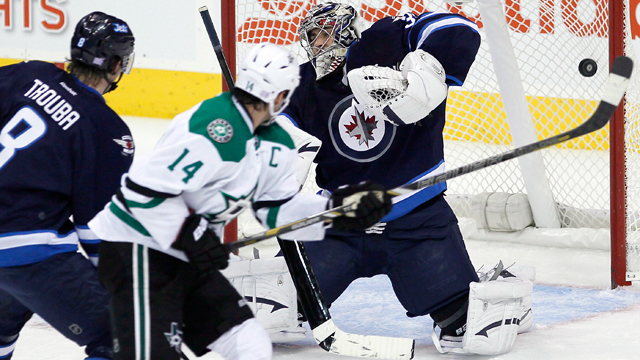Despite a recent hot streak by Ondrej Pavelec that’s taken his save percentage from .902 to .913, the Winnipeg Jets have a save-percentage problem — one that they’ve had since moving from Atlanta.
Pavelec’s inability to stop a high-percentage of shots has been devastating to the Jets’ playoff hopes the past two seasons. In 2011-12, he posted a .906 save percentage on 2,036 shots. A .915 save percentage, which is about league average for starting goalies, would have resulted in 18 fewer goals against. With three goals being worth roughly one point in the standings, that would have netted the Jets an additional six points. Winnipeg missed the playoffs by eight points. Last season Pavelec posted a .905 save percentage on 1,251 shots. A .915 save percentage from him would have resulted in about 13 fewer goals against — or about four points in the standings, exactly the number Winnipeg missed the post-season by.
In short, it’s entirely plausible the Jets would have made the playoffs both of their first two seasons in Winnipeg, if only Pavelec had performed better.
There’s a line of thinking that says Pavelec’s save percentage isn’t a Pavelec problem but a Jets team-defence problem. While we don’t have the data to answer that conclusively, it seems unlikely. Here are the numbers teams have received from their starters (defined as the goalies with the most starts in each season) since the beginning of the 2011-12 season:
There are a number of bad teams (i.e. playoff-less) found in the middle of the table — Edmonton, Buffalo and Carolina all jump out. The Oilers have a horrendous defensive reputation and Devan Dubnyk has been much maligned. He’s still managed to put up a save percentage in the middle of the table. Ryan Miller has given the Sabres average starting goaltending, despite Buffalo being a poor team.
It’s also worth noting that, of the four teams adrift at the bottom of the table, three appear to have concluded that the problem is their starting goalies, not (or at least, not just) some sort of team-wide defensive problem. New Jersey acquired Cory Schneider. Tampa Bay cycled through a number of goalies before arriving at Ben Bishop as a starter. Philadelphia bought out Ilya Bryzgalov and brought in Steve Mason — which doesn’t really seem like a solution, but that’s Philadelphia.
In Winnipeg, it’s really question of what’s more likely: that Pavelec has not been a No. 1-calibre goalie or that the Jets are a uniquely terrible defensive team?
He’s a relatively young goalie and young goalies are usually given a fair amount of slack. That being said, the ones who get as much opportunity as he’s had usually post a significantly better save percentage relative to the league average than he has. Using the data at Hockey-Reference.com and blending it with the data at quanthockey.com, we can compare the save percentages that of the 20 goalies who’ve faced at least 6,000 shots through age 25 since 1983-84 with the league average for the seasons in which they played:
Of the 20 goalies, 14 posted a save percentage better than the league average through age 25. This makes sense if you believe that NHL teams likely have a preference for established goalies and that you have to appear to be something special if you want to earn a No. 1 job. Pavelec sits second last on the list, right below Tim Cheveldae, another guy familiar to Jets fans. Pavelec has been unusually bad for a young goalie who has seen as many shots as he has.
There’s a lot of uncertainty involved in running a hockey team. Nobody can know definitively whether the Jets save-percentage problem is goalie-related or system/skater related, although there’s reason to believe it’s due to a goaltender who isn’t up to par. Unfortunately for the Jets, they’re committed to Pavelec for the rest of this season and three more to come at $3.9 million per year. There’s probably a temptation, when such a long, rich commitment to a player exists, to try and convince yourself that the problem is something that’s more readily fixed.
The problem with that is if you’re wrong, it can cost you more games and more time. Winnipeg’s backup, Al Montoya, is on a one-year deal. If Pavelec provides the Jets with another below average save percentage by starting goaltender standards, they really should consider the possibility that he is simply a below average starting goalie and sign one of the league-average starters who slips through the cracks next summer.
All teams make mistakes with players. And occasionally, they are expensive. The best teams are the ones that admit the mistakes and have, at the very least, a backup plan. The Jets haven’t their first two years in Winnipeg and it’s cost them. They’d be wise to come up with a better option than Chris Mason or Al Montoya soon, before another season slips away.



